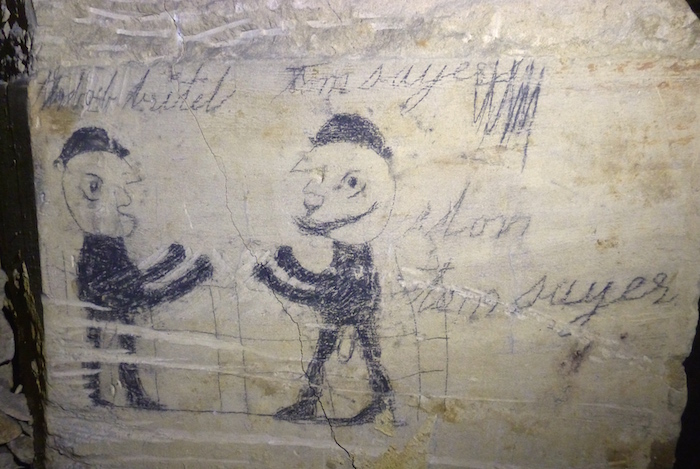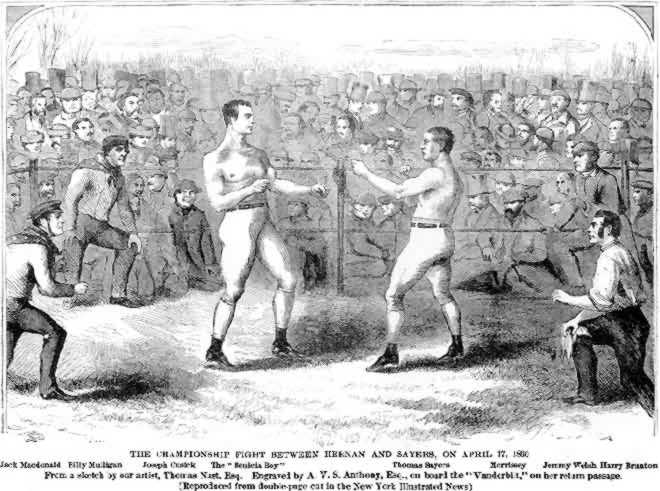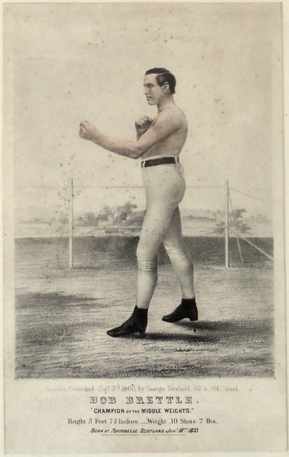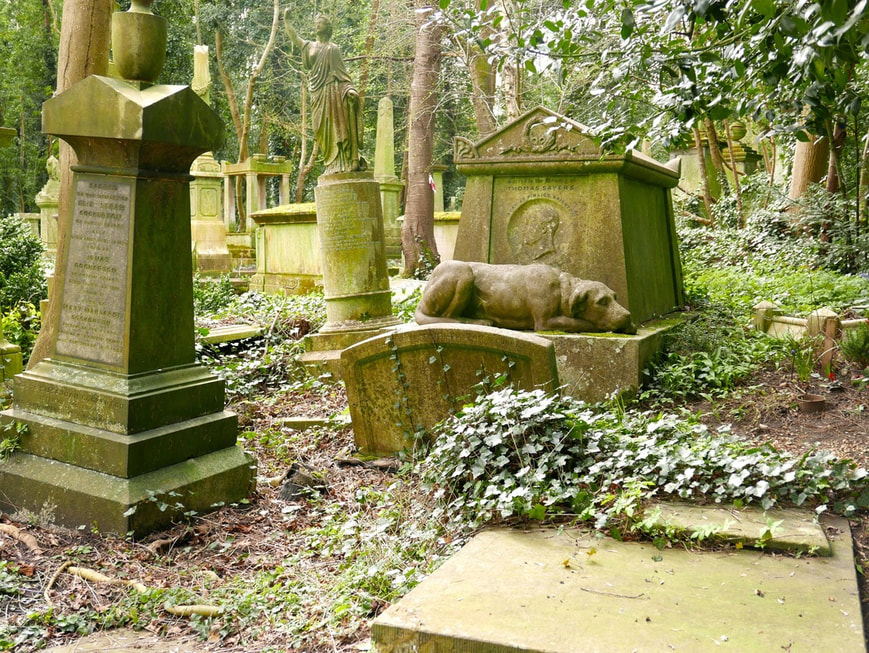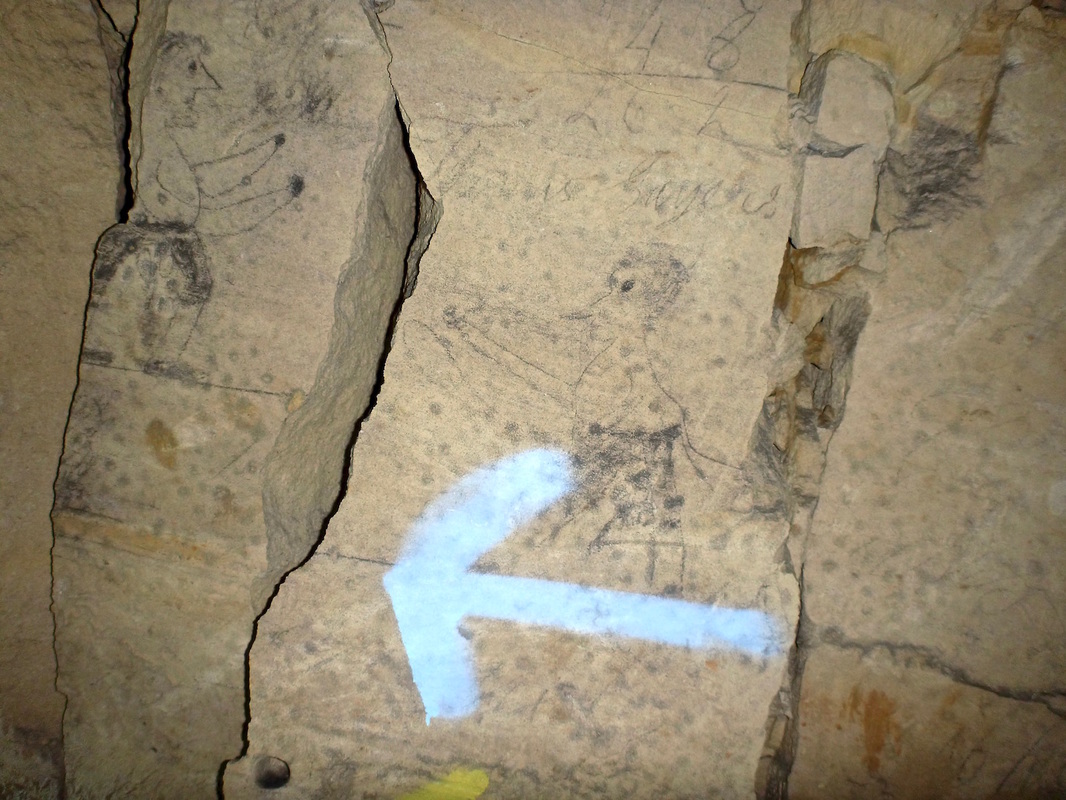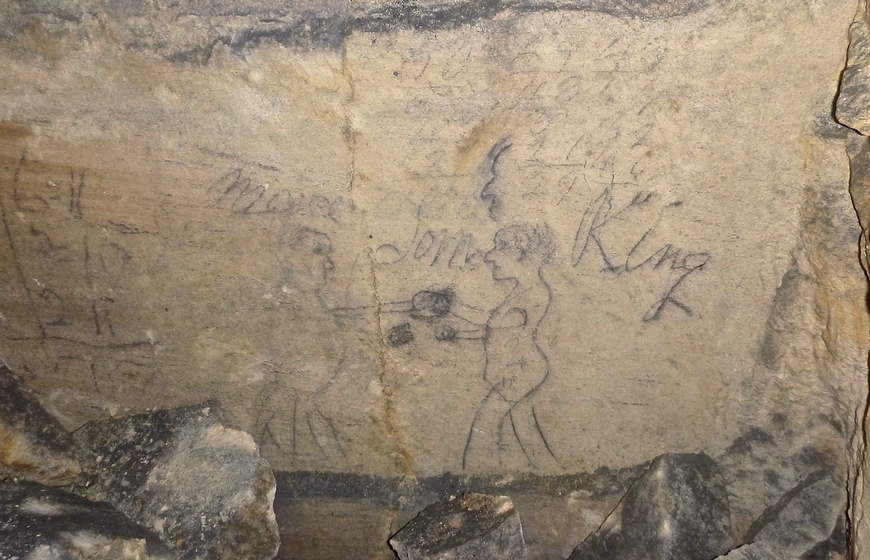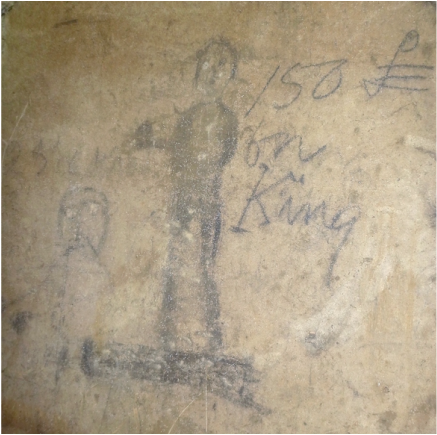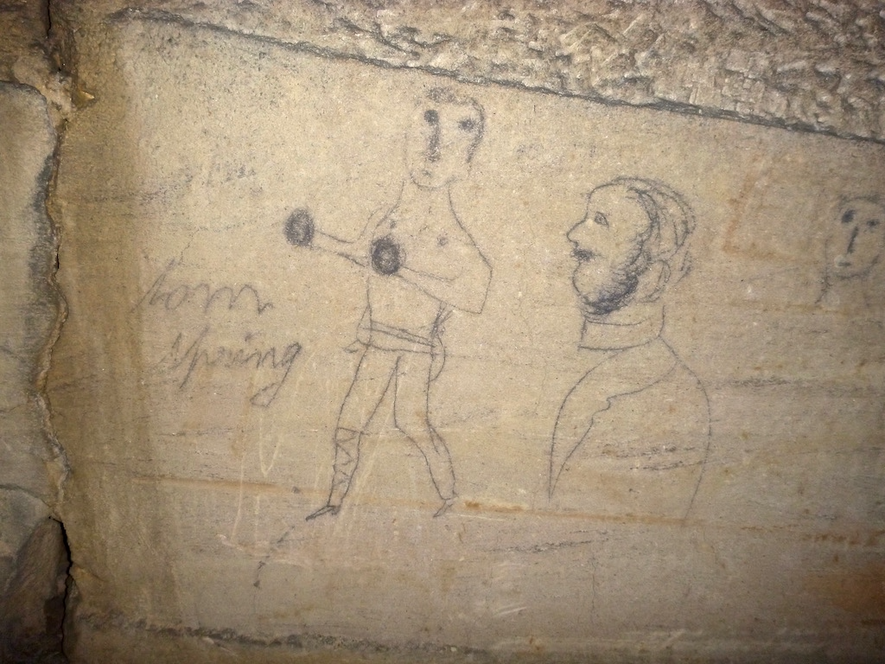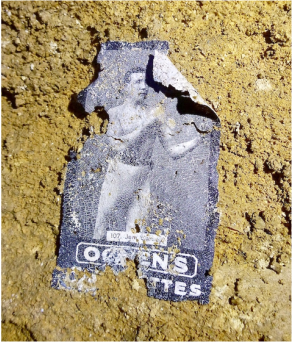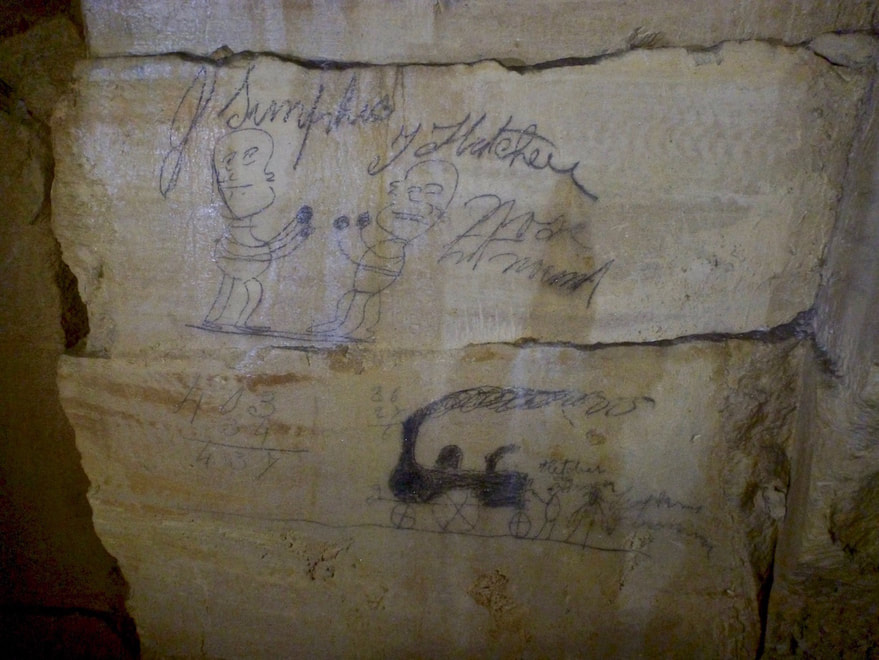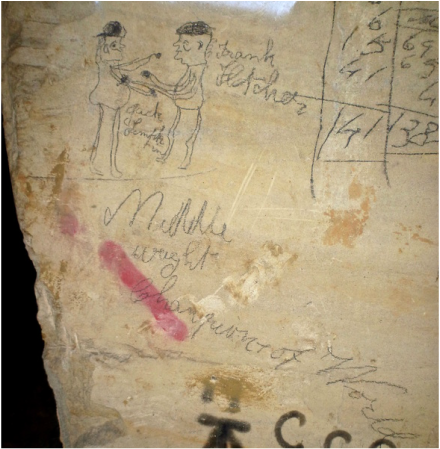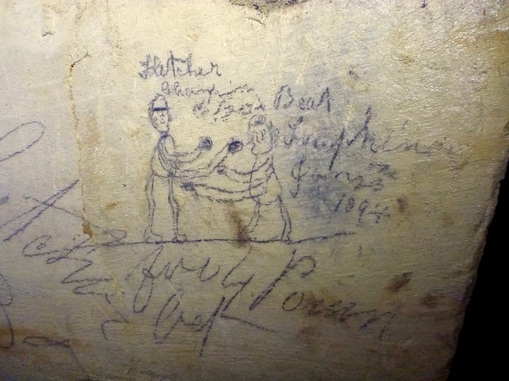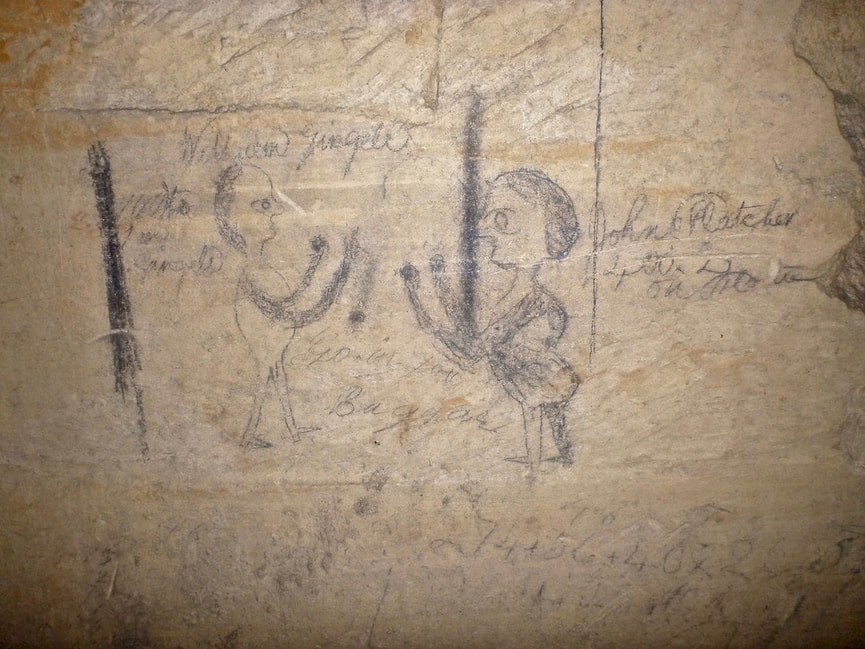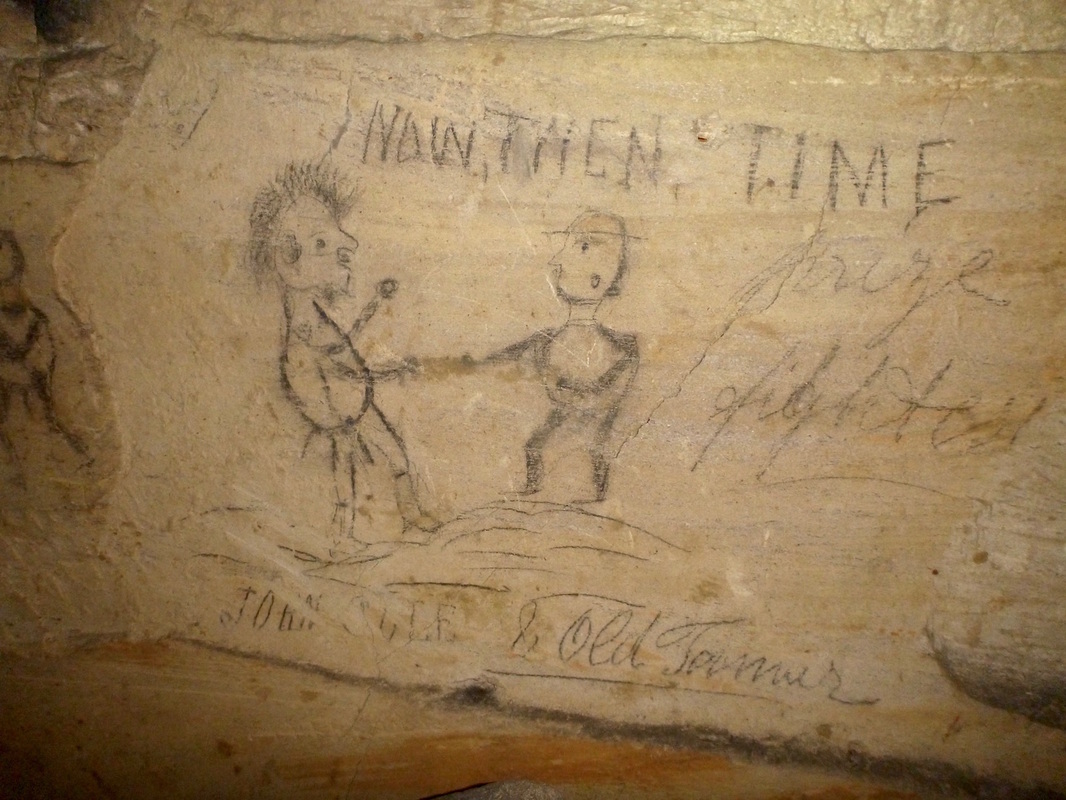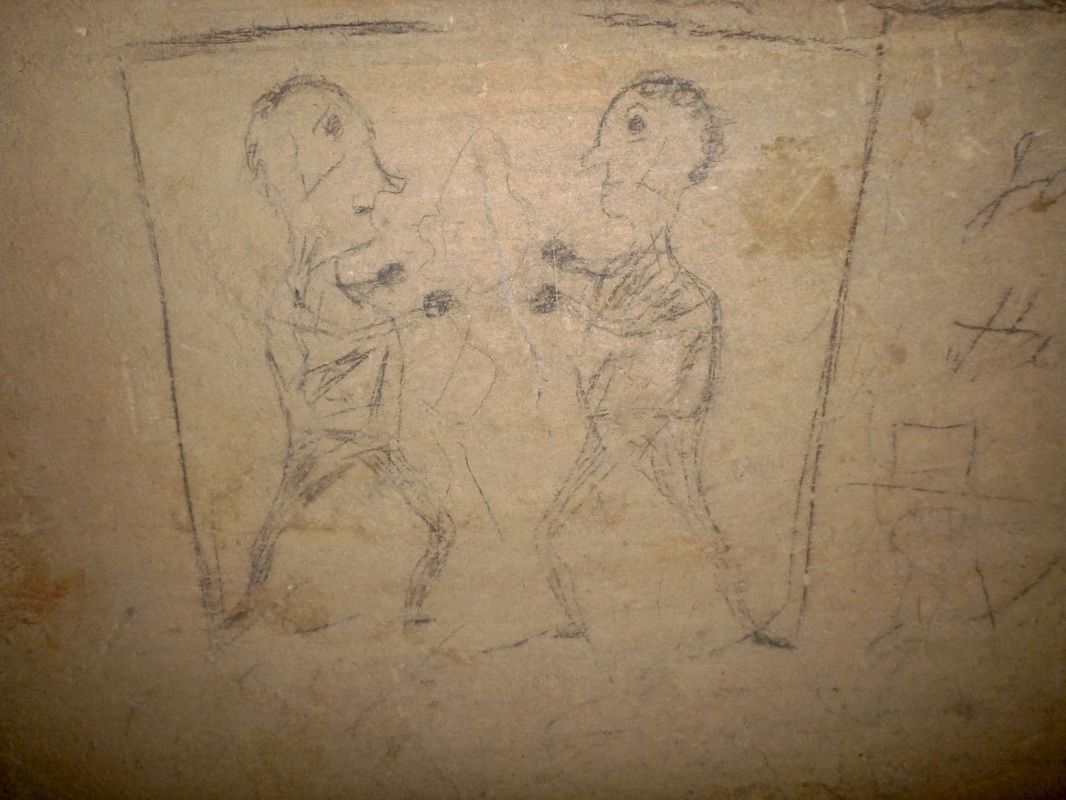Quarrymen and Boxing Mark Jenkinson December 2016
All underground photographs courtesy Mark Jenkinson
All underground photographs courtesy Mark Jenkinson
Appropriately for their tough lifestyle, Victorian quarrymen were very interested in boxing. This is evident from the many depictions underground in Box of fighting. The sketches are always the same: a side-on view of two men facing-off, with fists raised. Sometimes national or international fighters are named, but often it is just some of the pugilistic quarrymen.
Tom Sayers v Bob Brettle, 1859
The heading picture shows a professional fight between Tom Sayers and Bob Brettle. The quarryman who drew it had difficulty with the spelling (Britel instead of Brettle) but these are clearly the two protagonists involved. They only fought once, so we can accurately identify the occasion, 20th September 1859 at Ashford, Kent.
Tom Sayers was an English bare-knuckle prize fighter before the Queensberry Rules of boxing were adhered to in about 1867. Sayers was very successful, but was only 5 ft 8 in tall, and weighed under 11 stones, so he frequently fought much bigger men. However, his opponent in this bout, Bob Brettle, was of very similar stature (5 ft 7¾ in and 10 st 2 lb according to the image below). Sayers was national champion at this time and Brettle was not as strong a fighter. Sayers won after Brettle dislocated his shoulder in the 7th round. (Illustrations below courtesy Wikipedia)
The heading picture shows a professional fight between Tom Sayers and Bob Brettle. The quarryman who drew it had difficulty with the spelling (Britel instead of Brettle) but these are clearly the two protagonists involved. They only fought once, so we can accurately identify the occasion, 20th September 1859 at Ashford, Kent.
Tom Sayers was an English bare-knuckle prize fighter before the Queensberry Rules of boxing were adhered to in about 1867. Sayers was very successful, but was only 5 ft 8 in tall, and weighed under 11 stones, so he frequently fought much bigger men. However, his opponent in this bout, Bob Brettle, was of very similar stature (5 ft 7¾ in and 10 st 2 lb according to the image below). Sayers was national champion at this time and Brettle was not as strong a fighter. Sayers won after Brettle dislocated his shoulder in the 7th round. (Illustrations below courtesy Wikipedia)
Tom Sayers’ final and most renowned fight in his career followed the Brettle fight, taking place in 1860. It was against US champion John Camel Heenan, and is regarded as boxing’s first world championship. It was a brutal contest lasting 42 rounds and over 2 hours. It ended in a controversial draw after the crowd invaded the ring, possibly because Sayers was looking likely to lose.
The newspaper illustration above left shows Sayers diminutive stature compared with Heenan.
The newspaper illustration above left shows Sayers diminutive stature compared with Heenan.
Tom Sayers never fought again after the Heenan match and died in 1865, aged only 39. He has a particularly fine tomb in Highgate Cemetery, which features a sculpture of his dog, Lion. His funeral reputedly attracted a crowd of 10,000; he was a real sporting celebrity of his time.
|
Although the quarry sketch of the Sayers-Brettle fight is undated, it must have been drawn during or after 1859. And if a Box quarryman was to draw an illustration after 1860 of any Sayers fight, I think it would be of the famous Heenan fight rather than the bout against the less illustrious Brettle. Therefore, I strongly suspect this drawing to have been drawn contemporaneously by a quarryman in late 1859 or early 1860.
Sayers appears elsewhere in Box quarry, but not as distinctly; for example, in the photograph right, which when viewed at high resolution more clearly says Tom (or Thomas) Sayers. Unfortunately, some modern explorers deemed their painted direction arrow more valuable than the context of Victorian inscriptions. |
Tom King v Jem Mace, 1862-63
The underground sketch in Box quarry of a fight between Tom King and Jem Mace is less clearly drawn than the Sayers-Brettle match, but fortunately the names are distinct.
The underground sketch in Box quarry of a fight between Tom King and Jem Mace is less clearly drawn than the Sayers-Brettle match, but fortunately the names are distinct.
Tom King, a Londoner, was another successful English prize fighter, who learnt to box while a young sailor in the Royal Navy.
He first fought Jem Mace in 1862. Jem Mace, who originated from Norfolk, had become English champion in 1861 and he successfully defended his title against Tom King after a gruelling 43-round fight. However, there was a re-match in 1863 which King won in the 21st round.
He first fought Jem Mace in 1862. Jem Mace, who originated from Norfolk, had become English champion in 1861 and he successfully defended his title against Tom King after a gruelling 43-round fight. However, there was a re-match in 1863 which King won in the 21st round.
|
King then went on in the same year to fight the American John C Heenan in the UK, like Tom Sayers before him. King won this fight, although yet again there was some controversy and a ring invasion by the partisan crowd. As it is undated, we cannot tell which of Mace and King’s two fights is being depicted in the quarry sketch, but clearly 1862 or 1863 is the likely date of this graffiti.
In another part of Box quarry, there appears an interesting sketch with the words 150 £ on King. With research about the boxer Tom King fresh in my mind, I wondered whether it referred to winnings or perhaps a wager. The going rate for the championship fights involving Heenan appear to have been in the £2,000-£3,000 range. Using a currency calculator, an approximate factor of 100 is given for 1860’s prices in today’s money.[1] A £15,000 wager seems implausible for a quarryman, so perhaps it was just wishful thinking! |
Tom Spring
Tom Spring was yet another English champion bare-knuckle fighter, but his time was much earlier than the other fighters we have looked at, as he retired in 1824.
Tom Spring was yet another English champion bare-knuckle fighter, but his time was much earlier than the other fighters we have looked at, as he retired in 1824.
While not inconceivable, I do not think this sketch dates from this period, as the vast majority of inscriptions date from the mid 19th century onwards. I suspect this is more of a reminiscence from an old quarryman, perhaps marking Spring’s passing in 1851.
|
Jem Carney
My final example of a professional boxer's representation in Box quarry is a rarity for being not a charcoal sketch but the remains of a 1902 Ogden’s cigarette card. For obvious reasons, paper artefacts are not well suited for a long life in a damp underground quarry. Furthermore, spotting a fading card just a few centimetres tall stuck on the wall in a labyrinthine system of 50 miles or so of pitch dark passages requires some good fortune. Jem Carney was born in Birmingham but was of Irish descent. He was an 1880s English lightweight champion. From the account of a 74-round epic against Irish-American Jack McAuliffe, Carney was a ferocious fighter. Right: Remains of cigarette card found underground |
Fighting quarrymen
Now that we have seen the quarrymen’s interest in national and international boxing, we can look at depictions of fighting closer to home. The sketch below shows Jack Simpkins facing off against Frank Fletcher. Frank Fletcher was born in 1875, son of Henry Fletcher, a quarryman. We can see from the 1891 census that like his father, Frank too had become a quarryman by the time he was 16. Frank was reputed to be a notorious fighter and poacher.[2] There is even an intriguing inscription underground about his being fined 5 shillings by a police constable for killing a lizard!
Now that we have seen the quarrymen’s interest in national and international boxing, we can look at depictions of fighting closer to home. The sketch below shows Jack Simpkins facing off against Frank Fletcher. Frank Fletcher was born in 1875, son of Henry Fletcher, a quarryman. We can see from the 1891 census that like his father, Frank too had become a quarryman by the time he was 16. Frank was reputed to be a notorious fighter and poacher.[2] There is even an intriguing inscription underground about his being fined 5 shillings by a police constable for killing a lizard!
Jack Simpkins was another quarryman who, again according to legend was the driver of a steam engine to which Frank Fletcher was fireman.[3] The sketch above is particularly interesting since it shows the two characters at work with their engine, as well as fighting.
Fletcher v Simpkins is depicted elsewhere too. The sketch above left jokingly refers to the victor being the middleweight champion of the World, so their fights don’t sound too serious !
In the graffiti above right, the same pair is fighting again. The inscription reads: Fletcher Champion of Box beat Simpkins Jan 23rd 1894. To this is added, in a slightly different style, more similar to Fletcher’s signature just seen to the left, for 4 pound bet. Again using the currency calculator, this amount seems to be around £400 in today’s money, which still seems rather high, so I wonder if there was some inflated bragging going on.
John Fletcher and William Gingell
The drawing below features another Fletcher, but this time it is John Fletcher who is fighting William Gingell. There appears to be some encouragement for one or both fighters in the form of Go in you buggar.
William Gingell was a quarryman born in 1864, son of an Ashley quarryman called John Gingell. We know the quarryman fighter Frank Fletcher of course, and his father Henry, but my census research for John Fletcher has been less conclusive, unless it perhaps refers to a contemporary quarryman from Kingsdown called James Fletcher.
In the graffiti above right, the same pair is fighting again. The inscription reads: Fletcher Champion of Box beat Simpkins Jan 23rd 1894. To this is added, in a slightly different style, more similar to Fletcher’s signature just seen to the left, for 4 pound bet. Again using the currency calculator, this amount seems to be around £400 in today’s money, which still seems rather high, so I wonder if there was some inflated bragging going on.
John Fletcher and William Gingell
The drawing below features another Fletcher, but this time it is John Fletcher who is fighting William Gingell. There appears to be some encouragement for one or both fighters in the form of Go in you buggar.
William Gingell was a quarryman born in 1864, son of an Ashley quarryman called John Gingell. We know the quarryman fighter Frank Fletcher of course, and his father Henry, but my census research for John Fletcher has been less conclusive, unless it perhaps refers to a contemporary quarryman from Kingsdown called James Fletcher.
I haven’t unearthed any further information for the last couple of fighting images that I include here. The inscription below left appears to read: Now then time, prize fighter, John Cole and Old James. The image below right is simply an unnamed pair, drawn in a slightly more sophisticated style than some of the more cartoon-like sketches we have seen.
Altogether, the Box quarries have quite a collection of boxing inscriptions, and I have not covered them all here. It shows that boxing played a significant part in quarrymen’s lives; there is certainly more boxing depicted than other sports, such as football.
Altogether, the Box quarries have quite a collection of boxing inscriptions, and I have not covered them all here. It shows that boxing played a significant part in quarrymen’s lives; there is certainly more boxing depicted than other sports, such as football.
Sources
Boxers
http://en.wikipedia.org/wiki/Tom_Sayers
http://en.wikipedia.org/wiki/Bob_Brettle
https://en.wikipedia.org/wiki/Thomas_King_%28boxer%29
https://en.wikipedia.org/wiki/Jem_Mace
https://en.wikipedia.org/wiki/Tom_Spring
https://en.wikipedia.org/wiki/Jem_Carney
An account of the Sayers-Brettle fight
(although this article quotes September 1858, I’m inclined to believe the Sayers timeline that puts it in September 1859):
http://www.thefreelibrary.com/Meet+Bob+Brettle,+the+bare-knuckle+boxing+landlord%3B+back+in+time.-a0160382044
Sayers-Heenan fight
http://www.theguardian.com/sport/blog/2010/apr/14/john-heenan-tom-sayers-boxing
Jem Mace - Bob Brettle
http://www.bbc.co.uk/norfolk/talk/talk_jem_mace.shtml
http://www.boxingtreasures.com/bobbrettle.html
Tom Sayers dog tombstone
http://www.victorianweb.org/sculpture/funerary/222.html
An account of Jem Carney v Jack McAuliffe
http://www.boxing.com/the_great_and_forgotten_jem_carney_and_his_74_round_war_with_jack_mcauliffe.html
1891 census
http://www.wiltshire-opc.org.uk/Items/Box/Box%20-%20Census%201891.pdf
Roger Tucker, Scripta Legenda Box Quarries - Volume 1
Roger Tucker, Some Notable Wiltshire Quarrymen
Boxers
http://en.wikipedia.org/wiki/Tom_Sayers
http://en.wikipedia.org/wiki/Bob_Brettle
https://en.wikipedia.org/wiki/Thomas_King_%28boxer%29
https://en.wikipedia.org/wiki/Jem_Mace
https://en.wikipedia.org/wiki/Tom_Spring
https://en.wikipedia.org/wiki/Jem_Carney
An account of the Sayers-Brettle fight
(although this article quotes September 1858, I’m inclined to believe the Sayers timeline that puts it in September 1859):
http://www.thefreelibrary.com/Meet+Bob+Brettle,+the+bare-knuckle+boxing+landlord%3B+back+in+time.-a0160382044
Sayers-Heenan fight
http://www.theguardian.com/sport/blog/2010/apr/14/john-heenan-tom-sayers-boxing
Jem Mace - Bob Brettle
http://www.bbc.co.uk/norfolk/talk/talk_jem_mace.shtml
http://www.boxingtreasures.com/bobbrettle.html
Tom Sayers dog tombstone
http://www.victorianweb.org/sculpture/funerary/222.html
An account of Jem Carney v Jack McAuliffe
http://www.boxing.com/the_great_and_forgotten_jem_carney_and_his_74_round_war_with_jack_mcauliffe.html
1891 census
http://www.wiltshire-opc.org.uk/Items/Box/Box%20-%20Census%201891.pdf
Roger Tucker, Scripta Legenda Box Quarries - Volume 1
Roger Tucker, Some Notable Wiltshire Quarrymen
References
[1] Currency calculator
[2] Roger Tucker, Scripta Legenda Volume 1
[3] Roger Tucker, Scripta Legenda Volume 1
[1] Currency calculator
[2] Roger Tucker, Scripta Legenda Volume 1
[3] Roger Tucker, Scripta Legenda Volume 1
